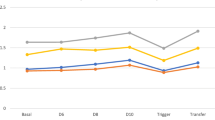Abstract
Purpose: Color Doppler imaging permits the accurate localization of vessels and high-frequency pulsed Doppler ultrasonography has improved the resolution of flow velocity waveforms. In this study, intraovarian arterial blood flow before and after follicle rupture in the natural cycle was examined using transvaginal color flow Doppler imaging and changes in intraovarian arterial resistance in relation to the outcome of infertility treatment was analyzed.
Methods: In a prospective study, 227 spontaneous cycles in 118 infertile patients who were undergoing infertility treatment at the division of Reproductive Medicine in our center were recruited in this study. The impedance to flow in intraovarian vessels was measured by means of transvaginal color flow Doppler imaging during the periovulatory period in the natural cycle of all patients. The pulsatility index (PI) of intraovarian arterial blood flow and pregnancy rate was evaluated.
Results: On the basis of PI values before and after follicular rupture, 227 cycles were classified into severely decreased (113 cycles) and not-severely decreased groups (114 cycles). The pregnancy rate per cycle in the severely decreased group was 18.6% (21/113), significantly higher than that in the not-severely decreased group (7/114; 6.1%, p = 0.004). The miscarriage rate was similar in the two groups.
Conclusions: A reduction in intraovarian blood vessel resistance is necessary to achieve pregnancy in a natural cycle.
Similar content being viewed by others
REFERENCES
Kurjak A, Kupesic Urek S, Schulman H, Zalud I: Transvaginal color flow Doppler in the assessment of ovarian and uterine blood flow in infertile women. Fert Steril 1991;56:870–873
Steer CV, Tan SL, Mason BA, Campbell S: Midluteal phase vaginal color Doppler assessment of uterine artery impedance in a subfertile population. Fert Steril 1994;61:53–58
Steer CV, Campbell S, Tan SL, Crayfold T, Mills C, Masan BA, Collins WP: The use of transvaginal color flow imaging after in vitro fertilization to identify optimum uterine conditions before embryo transfer. Fert Steril 1992;57:372–376
Scholtes MCW, Wladimiroff JW, van Rijen HJM, Hop WCJ: Uterine and ovarian flow velocity waveforms in the normal menstrual cycle: A transvaginal study. Fert Steril 1989;52:981–985
Steer CV, Campbell S, Phapiglione J, Mason BA, Collins WP: Transvaginal color flow imaging of the uterine arteries during the ovarian and menstrual cycles. Hum Reprod 1990; 5: 391–395
Sladkevicius P, Valentin L, Marsal K: Blood flow in the uterine and ovarian arteries during the normal menstrual cycle. Ultrasound Obstet Gynecol 1993;3:199–208
Tan SL, Zaidi J, Campbell S, Doyle P, Collins W: Blood flow changes in the ovarian and uterine arteries during the normal menstrual cycle. Am J Obstet Gynecol 1996;175:625–631
Campbell S, Bourne TH, Waterstone J, Reynolds KM, Crayford TJB, Jurkovic D, Okokon EV, Collins WP: Transvaginal color blood flow imaging of the periovulatory follicle. Fert Steril 1993;60:433–438
Nakahara K, Saito H, Saito H, Ito M, Ohta N, Sakai N, Tezuka N, Hiroi M, Watanabe H: Incidence of apoptotic bodies in membrane granulosa of the patients participating in an in vitro fertilization program. Fert Steril 1997;67:302–308
Toya M, Saito H, Ohta N, Saito T, Kaneko T, Hiroi M: Moderate and severe endometriosis is associated with alterations in the cell cycle of granulosa cells in patients undergoing in vitro fertilization and embryo transfer. Fert Steril 2000;73:344–350
Seino T, Saito H, Kaneko T, Takahashi T, Wawachiya S, Kurachi H: Eight-hydroxy-2$’$-deoxyguanosine in granulosa cells is correlated with the quality of oocytes and embryos in an in vitro fertilization-embryo transfer program. Fert Steril 2002;77:1184–1190
Saito H, Kaneko T, Takahashi T, Kawachiya S, Saito T, Hiroi M: Hyaluronan in follicular fluids and fertilization of oocytes. Fert Steril 2000;74:1148–1152
Yokota H, Nakai A, Oya A, Koshino T, Araki T: Changes in uterine and ovarian impedance during the periovulatory period in conception and noncoception cycles. J Obstet Gynecol Res 2000:26;435–440
Author information
Authors and Affiliations
Corresponding author
Rights and permissions
About this article
Cite this article
Nakagawa, K., Ozawa, N., Takamatsu, K. et al. A Reduction in Intraovarian Arterial Blood Flow Resistance After Ovulation is Necessary to Achieve Pregnancy in Natural Cycle. J Assist Reprod Genet 22, 9–14 (2005). https://doi.org/10.1007/s10815-005-0814-z
Received:
Accepted:
Issue Date:
DOI: https://doi.org/10.1007/s10815-005-0814-z




